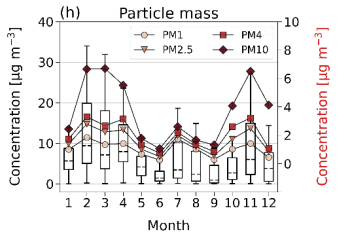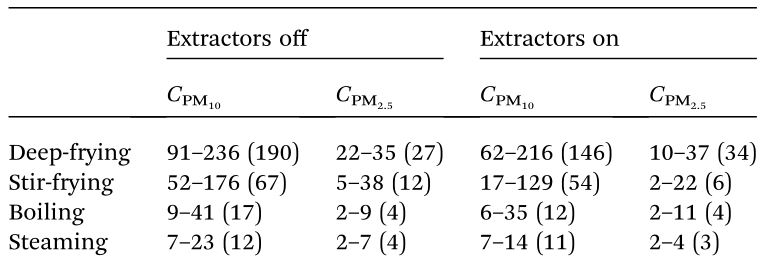PM2.5 and PM10 have not been new items for those familiar with air pollution already, these particles are relevant to the entire ecosystem. Regardless of the snow-covered Arctic or the smoky kitchen, the generation and emission of particles in everywhere significantly impact the earth’s ecology and human health. Palas® Fidas® 200 ambient air quality continuous monitoring system has been used indoors and outdoors to provide accurate particle monitoring solutions for different research teams. It helps further understand the pattern of particle emissions and makes contributions to environment protection.

Ambient particle matter monitoring in the Arctic
Oceanic dimethyl sulfide (DMS) is one source of atmospheric sulfur and the oxidation products formed by DMS will contribute to the growth of aerosol particles. This has implications for the particles’ ability to form clouds in the atmosphere, so the performance of the clouds in the Arctic to block radiation will also be influenced. For environment protection, researchers spent a full year in 2020 observing DMS-formed hydroperoxymethyl thioformate(HPMTF) at the Zeppelin Observatory in the Arctic. Palas® Fidas® 200 S is used to measure particulate mass concentrations including PM1, PM2.5, PM4 and PM10. And its monitoring data here helped to study the effect of DMS’s ability to contribute to particle growth and cloud formation.

Views around the Zeppelin Observatory
Fidas® 200 S belongs to the Palas® Fidas® 200 product series. It is equipped with an IP65 weatherproof housing (-20°C/+50°C) and can be used independently outdoors. In the one-year-long monitoring in the Arctic, it continuously and stably provided a variety of PM mass concentration data. As shown below, PM concentration was low in summer (June to September) and rose in winter and spring (November to April). Data from Fidas® 200 S validated the seasonality of the particle-phase DMS oxidation products and provided data support for the Arctic environment research.

Monitoring data from Fidas® 200 S
Particle generation during cooking in the kitchen
In addition to the ocean, particle emissions from cooking also play a critical role in affecting particle generation. British researchers then conducted a study in the kitchen areas of five student studio flats. They investigated the use of different cooking methods (deep-frying, stir-frying, boiling and steaming) and extractors to assess their effects on PM concentrations and emission rates. The shown below are ranges and medians of mean concentrations of PM10 and PM2.5 of cooking activities of each cooking method with or without the extractors on. It can be seen that fewer particles appeared when people steamed and keep extractors on. So this way can help improve indoor air quality and protect the ambient air indoors.

Fidas® 200 ambient air quality continuous monitoring system was used as the reference instrument in this study. It provided accurate PM values and helped to prove the monitoring capability of the other sensor in the study. Fidas® 200, using single particle measurement technology, has been certified by TÜV Rheinland as well as MCERTS in the UK. It can monitor PM10 and PM2.5 continuously with high resolution. Its simple operation and low O&M costs also make it ideal for indoor ambient air monitoring.
Fidas® 200 ambient air quality continuous monitoring system

Fidas® 200 (as well as Fidas® 200 S and Fidas® 200E) is an optical scattered particulate matter continuous monitoring system that has been protected by several patents. The system for single particles can calculate PM2.5 and PM10 simultaneously. Fidas® 200 S is equipped with an IP65 weatherproof housing (-20°C/+50°C) and can be used independently outdoors. It is suitable for both alpine and coastal applications.
Advantages
· Certified according to TÜVRheinland Germany and MCERTS UK
· Continuous and simultaneous real-time measurement of multiple PM values
· Additional information based on particle number concentration
· Adjustable time resolution from over 1s to 24h
· Cloud zone via Palas® server for worldwide data retrieval
· Low maintenance, low consumables
Applications
· Regulatory pollution control in monitoring networks
· Long-term studies of particles
· Mobile navigation monitoring
· Emission dispersion studies
Palas® organizes a series of webinars on various topics to share professional knowledge of aerosol measurement technology. Palas® technical experts and industry scholars from all over the world will give you detailed online explanations. Welcome to register to attend and learn more about the webinars as soon as possible!
Time: Friday, May 12, 2023 13: 30 – 16: 30
Topic: Application of particle size spectrometer in ambient air particulate matter monitoring
Speaker: Director Liu
Shenyang EMC
Topic: Scanning electromigration particle size spectrometer capabilities and applications: from laboratory to field observations
Speaker: Mr. Ling Jiang
Dalian Institute of Chemical Physics, Chinese Academy of Sciences
Topic: New HJ653 and validating Palas single particle counting aerosol particle size distribution spectrometer technology
Speaker: Ms. Jun Deng
Palas® Country Product Manager—Environmental & Automotive
Welcome to register for the conference!
Click here to register

